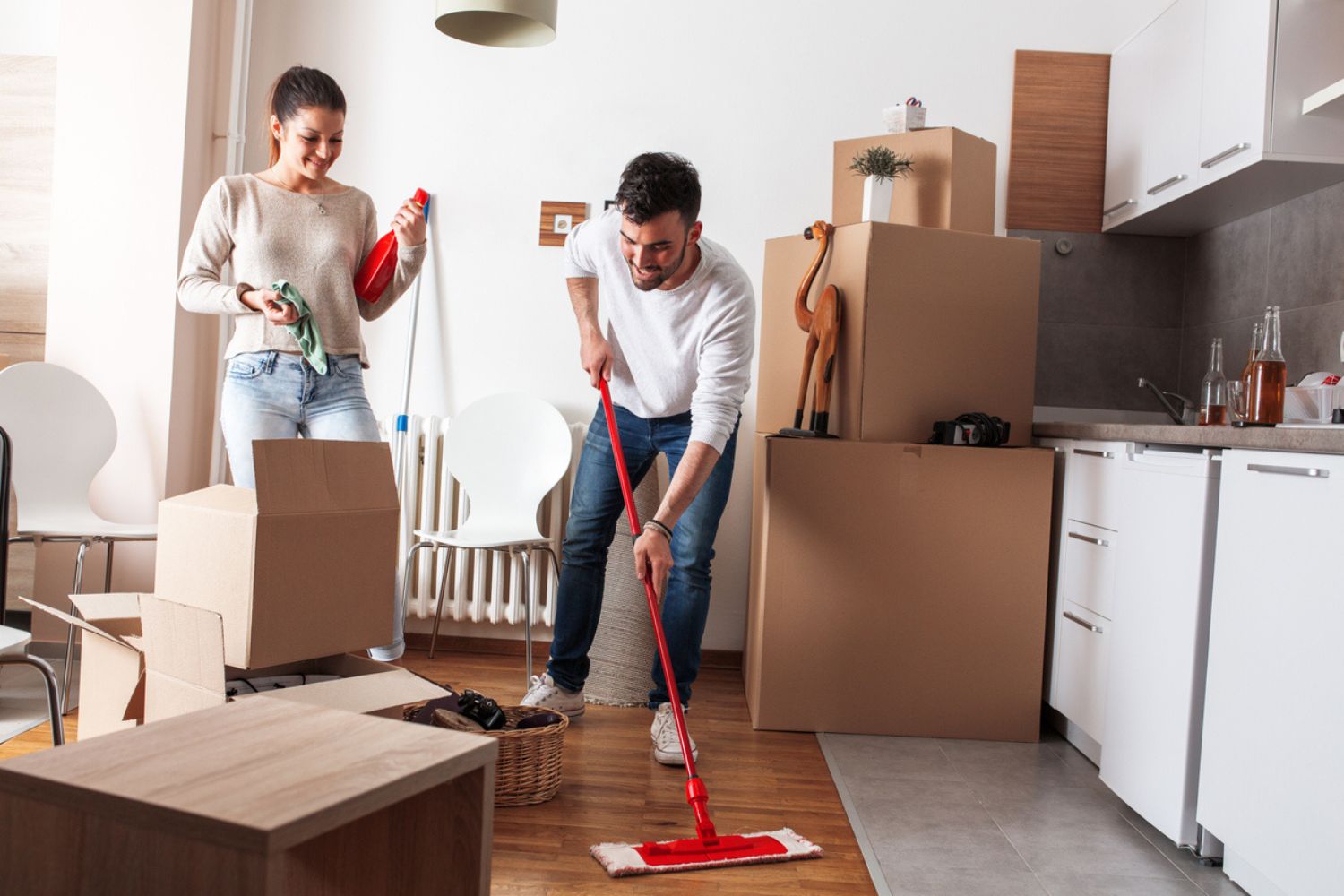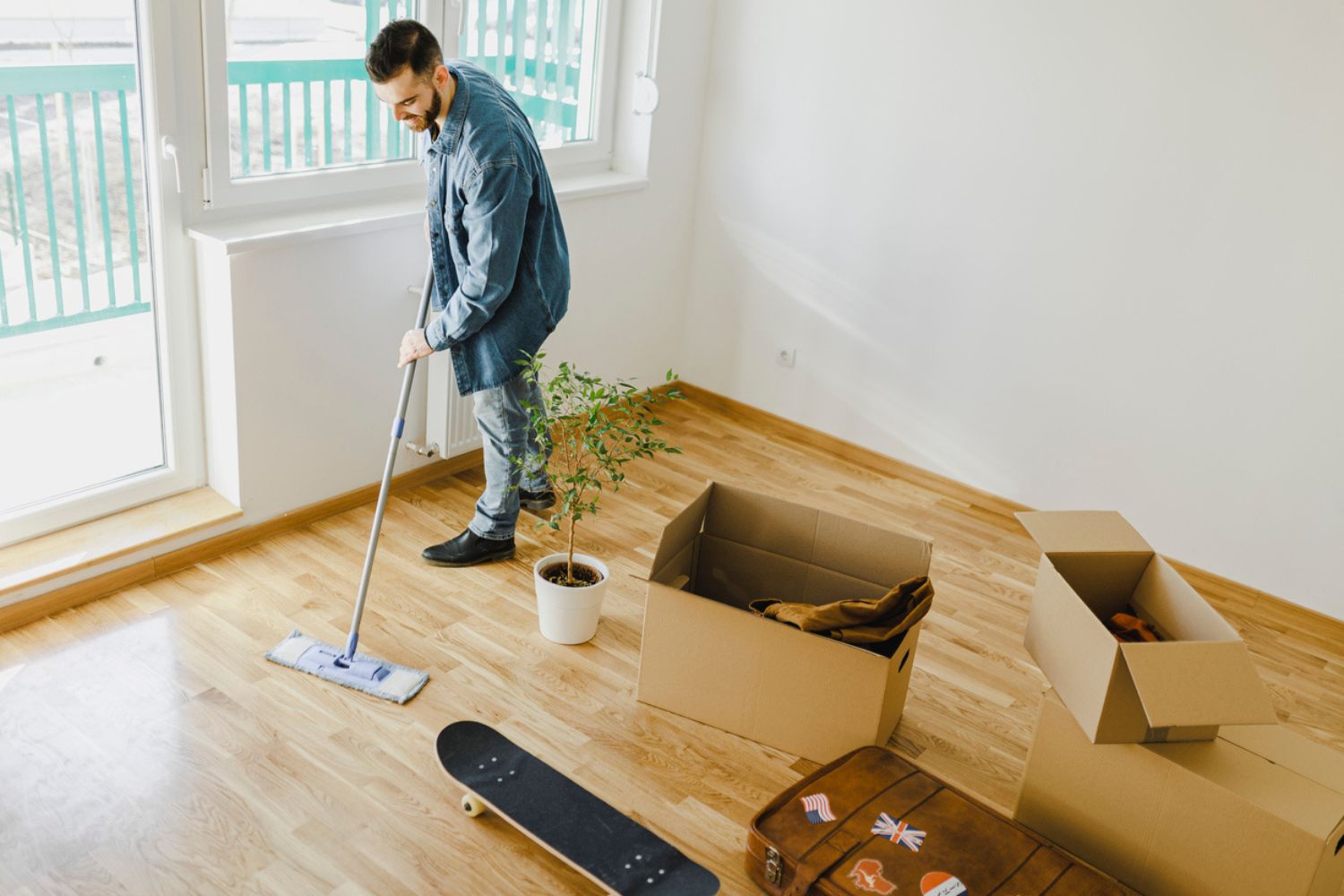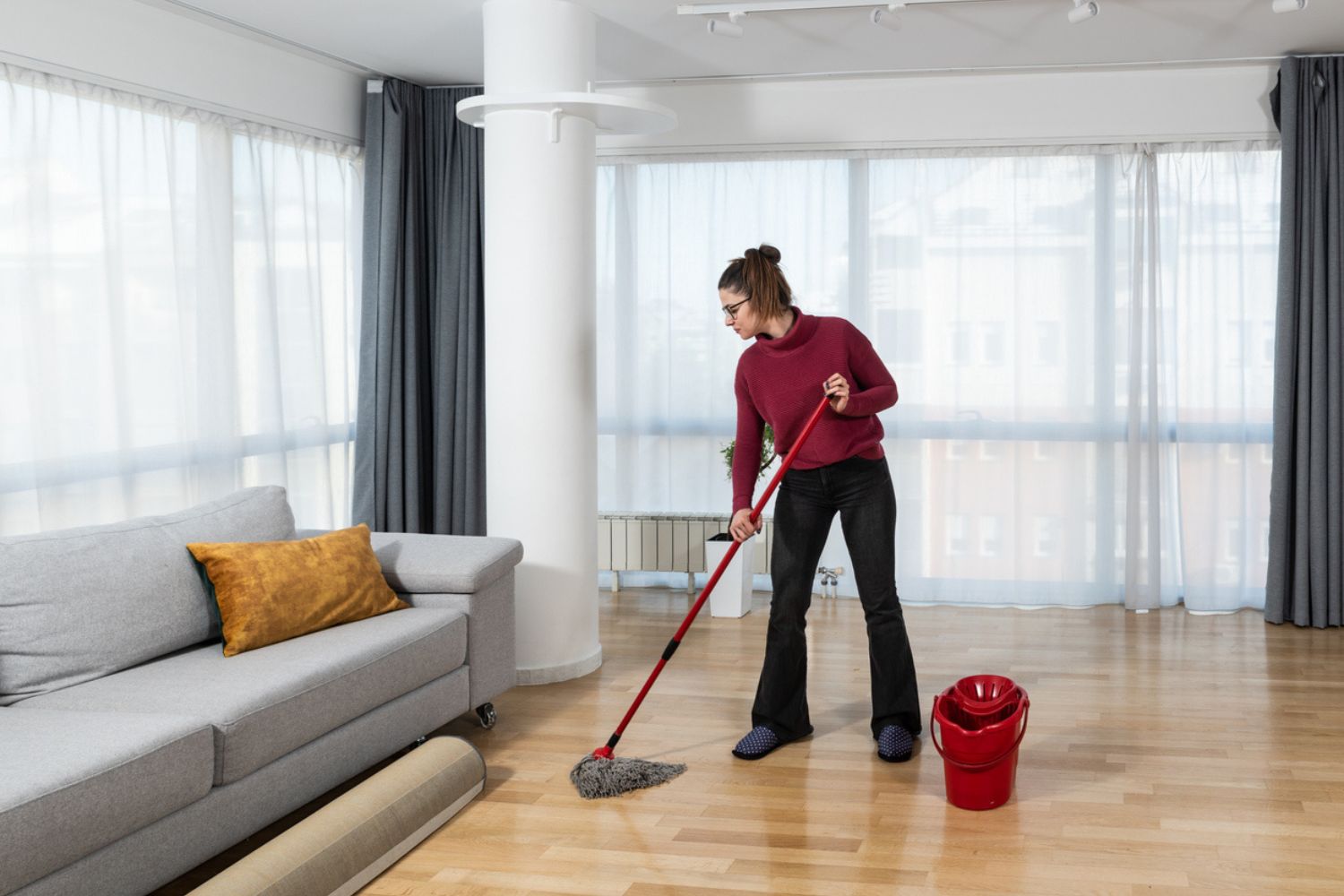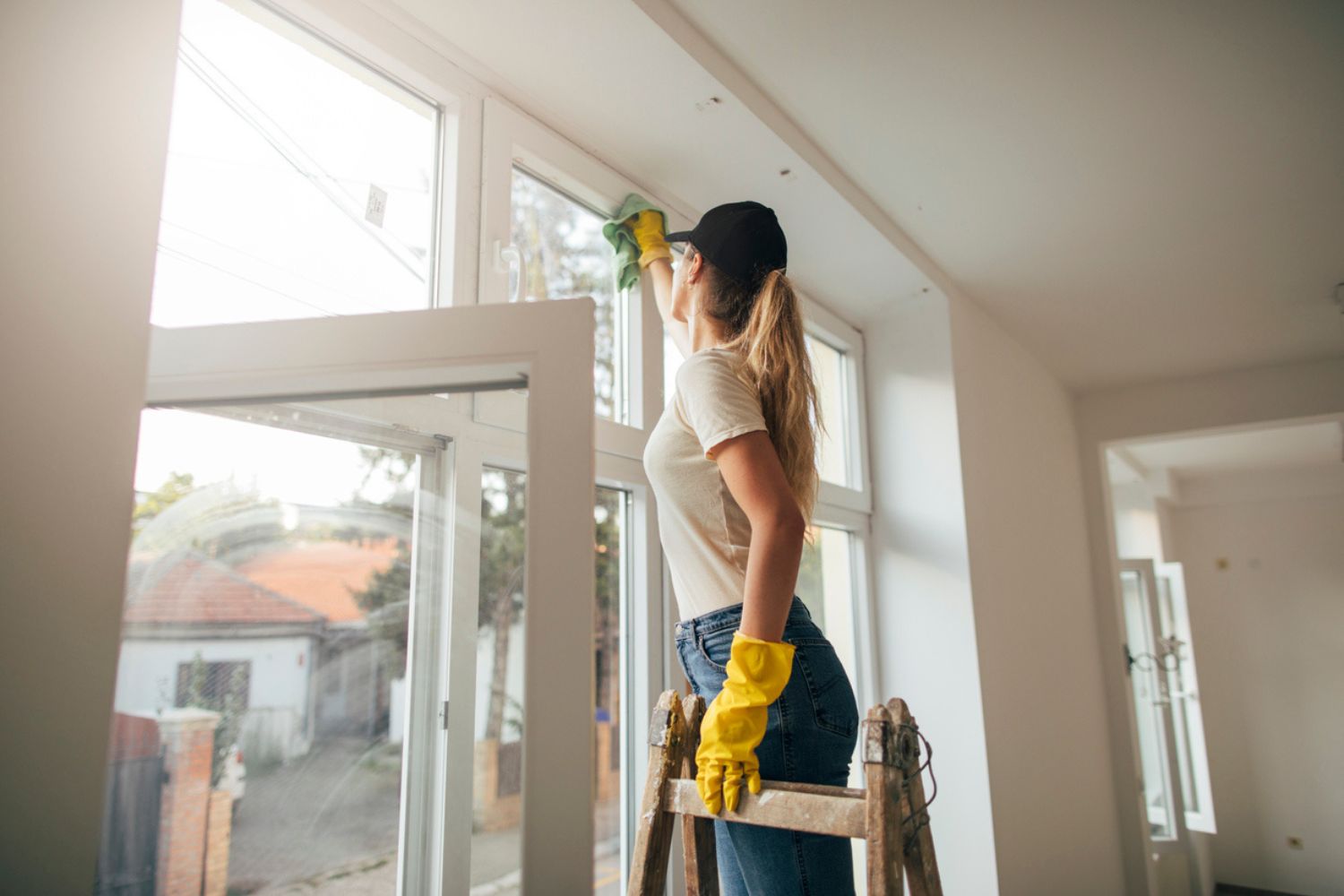We may earn revenue from the products available on this page and participate in affiliate programs. Learn More ›
Highlights
- Move-out cleaning services typically cost between $110 and $650, with a national average cost of $360.
- Some of the main factors that affect move-out cleaning cost include the size and type of home, the condition of the property, the services required, the cost of labor, and the home’s geographic location.
- Move-out cleaning may be required by a renter’s lease, although it’s a worthwhile service even if not required. Cleaning a home before moving out—especially if pets have lived there—is courteous to new residents.
- A homeowner or renter may be able to perform their own move-out cleaning services if the home is in good condition. However, hiring a professional cleaner can help save time—and can be necessary for homes that need a little extra care.
The last thing most people want to do after packing up their entire home, loading boxes onto a truck, and dealing with all of the bits and pieces of moving is scrub down the home they’re leaving. But in addition to being a kindness to the new residents, move-out cleaning can be necessary. It’s astonishing how dirty even a clean home can look when all of the furniture and decor is removed; a house that looked pretty decent with everything in place might not meet the “broom clean” standard set in the real estate contract. And nobody wants to deal with last-minute pushback from a buyer who looks at the empty space and feels it’s not what they thought they were getting.
Hiring professional cleaners to do a move-out clean is an extra moving expense—according to Angi and HomeAdvisor, move-out cleaning costs between $110 and $650, with an average price of $360. But in the grand scheme of moving costs, hiring a pro may be well worth it to preserve the sanity of the people moving out and to welcome in the new residents.
Factors in Calculating Move-Out Cleaning Cost
No two homes are exactly alike, so the costs involved in hiring cleaners will vary based on a number of factors. While there are move-out cleaning cost calculators online, a more accurate estimate can be determined by taking a thorough look at what needs to be done and doing some comparison shopping.

Home Size
Quite simply, larger homes cost more to clean than smaller ones. Larger homes generally have more bedrooms and bathrooms, so the square footage plus the different spaces adds up to more cost. While a 2-bedroom home between 1,000 and 1,500 square feet should average between $120 and $260 to clean, a 4-bedroom home between 2,000 and 3,000 square feet will cost nearly double that, averaging $240 to $380.
Home Type
Houses and apartments incur the same move-out house cleaning cost per square foot, so the size of the home matters more than the type of home in terms of the base cost of the cleaning. However, houses are more likely to require additional cleaning services and present different challenges that make them more expensive to clean, such as stairs, additional bathrooms, and garages. Rental properties often include a clause in the lease that requires tenants to pay for cleaning prior to the end of their lease, or they include a condition in the security deposit that covers additional or unexpected cleaning after a tenant leaves. As a result, move-out cleaning for rentals can cost a bit more than standard house or apartment move-out cleaning cost. If the rental was furnished, the upholstery will need to be cleaned prior to the arrival of new tenants; this is charged by the piece. Renters with carpeting will almost always need to add on the cost of professional carpet cleaning. Rental properties cost an average of $360 to clean after tenants depart.
Property Condition
The move-out cleaning of a home that is well maintained and reasonably tidy to begin with will have a lower cost estimate than cleaning of a home that is shambles when the cleaners arrive. When cleaners have to remove a lot of debris or furniture to access the area they need to clean, it will take longer for them to get their work done, which adds to labor costs. In addition, deep soiling or staining will require more time, effort, and cleaning products to address, so properties that are very dirty will cost more.
Services
Each cleaning company packages its services a little differently, so it’s important for customers to look closely to see what tasks are included. Nearly all cleaners will include dusting, cleaning, and disinfecting surfaces; vacuuming and mopping the floors; and cleaning and disinfecting the kitchen and bathroom. Others may include services such as cleaning the baseboards and spot-cleaning the walls in their base package. Upgrading the cleaning package can add interior cabinet cleaning, appliance cleaning, and stain treatment. Choosing the best eco-friendly cleaning products may also add to the overall cost. Beyond that, most move-out cleaning services will provide a menu of add-on options that can be tacked on to the base package, priced by task and by number of rooms. Because of these variations, it’s a good idea for the customer to shop several companies and carefully compare their packages and the cost of add-on services to find the right combination for their needs.
Labor
Pricing of cleaning services usually includes the labor involved, and the cost of that can vary regionally. The cost overall can also vary based on the size of the team needed to clean the home and the number of hours needed to clean it. A four-person team will take less time to clean a home than a two-person team, but customers will be compensating two additional people for the faster job, so the costs may balance out. Cleaning services will likely offer additional services beyond their packages that are priced specifically based on the length of time their employees will be working, so the number of cleaners and time required will shape the overall cost.
Geographic Location
As with many other home services, the going rate for house cleaning varies based on the market in the area in which the home is located. Customers residing in areas where the cost of living is higher should expect the cost of cleaning services to be higher than in other areas. It is important that customers note, however, that there may be a broader selection of cleaning services available in areas that are more affluent, as there’s more call for regular-maintenance house cleaning services in areas where residents can afford to pay for them; in turn, there may be some savings, in that greater competition can drive prices down. Customers will want to compare several companies to get a better idea of house cleaning prices in the area.

Additional Costs and Considerations
The base cost of a move-out cleaning is largely based on the size and type of the home, along with the condition and the degree of cleaning services that is necessary. However, there are additional services that customers may need to add, which can swiftly increase the cost of the cleaning, and some other distinctions that can affect the charges as well.
Standard Cleaning vs. Deep Cleaning
Customers can select from a variety of service levels when hiring professional cleaners. A basic cleaning includes wiping down surfaces, vacuuming, dusting, and thoroughly cleaning the bathroom and kitchen, and it will fall towards the lower end of the price range. Deep cleaning goes a step further and will include a more intensive scrubbing of surfaces and may include some appliances and light fixtures. Choosing a cleaning service specifically designed for customers moving out of their home will include walls, baseboards, and cabinets, along with other areas that tend to be overlooked by residents during regular cleaning but that become painfully obvious when the home is emptied. Move-out deep cleaning cost will be higher than the cost of a simple cleaning, but it may better meet the standard of a home transfer.
Additional Services
Basic move-out cleaning covers removal of dirt and grime from the surfaces, but in order to keep costs down, most companies offer a selection of additional services that customers can select. While this may feel a bit like bait-and-switch for a customer who chooses a base package and then realizes the additional services they need more than double the cost of the cleaning, thisapproach also prevents customers from being forced to pay for services they don’t need, such as carpet cleaning in a home with no carpets.

Types of Move-Out Cleaning
Customers have different cleaning needs when moving out of a home. In some cases, the home itself is pretty clean and doesn’t require a full-house scrub, but moving the furniture reveals squares and rectangles of carpet that are a whole different shade than the rest of the room. Or removing the curtains reveals just how often the dog pressed its nose against the glass, or the removal of area rugs displays how worn and dirty the flooring is. During a move, tackling those surprise areas can be the straw that breaks the camel’s back, in which case it’s good to know that professionals can come in to take on just one or two difficult jobs.
Carpet
Looked closely at the carpeting lately? It’s probably best not to—when it becomes apparent that the carpet hasn’t been cleaned in some time, it’s a good idea to get some help shampooing or steam cleaning it. Carpets collect and hold every bit of dirt and dust that flies by, pet hair, food crumbs, and, if there are children in the home, glitter and other craft items. Because of this, many new residents look askance at the carpet and would prefer to replace it immediately. As an add-on service, carpet cleaning will raise the cost of the cleaning job by $120 to $240, depending on the number of rooms and the soil level of the carpet. The cost covers the machinery needed for the cleaning, the cleaning solution, and the time and energy of the cleaners.
Windows
Windows are just glass, so it seems like giving them a wash should be an easy task, but getting windows to a streak-free shine takes a combination of the right tools and products and a lot of practice, especially with windows that tilt in so the exterior can also be easily cleaned. Having the windows cleaned will add $80 to $300 to the move-out cleaning services cost.
Appliances
Refrigerators can look tidy when they’re full of food, but remove the obstacles and they’re collectors of bits of food, rings from drippy containers, and splashes of leftover dinner. Similarly, ovens and stovetops can easily become coated with grease and dust. Even washing machines and dryers collect debris underneath and behind them. While a basic cleaning usually includes wiping down the exteriors of appliances, scrubbing the interior is a separate expense, and understandably so, as that kind of work is labor-intensive and requires extra supplies and products. This will add between $10 and $40 per appliance.
Blinds
Often overlooked by homeowners and renters as they go about their weekly cleaning routine, blinds attract dust, cooking grease, pet hair, and all manner of other particles. While a light haze can be easy to remove with a microfiber cloth, once a coating has started to build up, it can be difficult to remove. A great deal of patience and precision is necessary to clean blinds without tangling or damaging them, so adding the cost of cleaning blinds can be between $5 and $10 per set.
Hardwood Floor Polishing
While a standard move-out cleaning includes sweeping and mopping floors, hardwood flooring that hasn’t been polished or buffed in years can really bring down the appearance of a home. Polishing the hardwood floors will cost between $100 and $300, though the precise cost will depend on the condition and the square footage of the flooring.
Tile and Grout
As with other problem areas, mold and mildew along with sloughed skin cells and soap scum can build up quickly in the grout lines between bathroom tiles, and dirt and grit can collect in the grout of entryway flooring tiles. Cleaning tile and grout—which requires an eye for detail, the right brushes and cleansers, and a lot of close-up work—will add between $100 and $200 to the cost of the cleaning job, but it’s well worth it. Dull tiles and darkened grout develop over time and sneak up on a home’s residents, who perhaps don’t notice the difference until the grout and tile are cleaned. Tile and grout cleaning will brighten up the whole house.
Garage Cleaning
When homeowners are paying to have the house cleaned, it doesn’t make sense to leave out the garage. Depending on the size of the garage and the condition of the walls and flooring, the cost of cleaning the garage is generally between $70 and $200, provided that the shelving and walls are empty. Cleaning a garage may seem like an afterthought, but it’s storage space for the car and a lot of household, lawn, and garden items, so the new residents will be pleased to find it tidy and ready to move into.
Junk Removal
What to do with the items, especially large ones, that residents don’t want to take with them to a new home but can’t fit in a trash bin? If there are only a few items, a local sale site or bulk trash pickup can be an option. Calling a junk removal service to take away the unwanted items, including furniture, appliances, construction debris, and other items, can cost between $60 and $370. Workers will carry out and haul away the junk and salvage it or deliver it to a dump or landfill.
Do I Need Move-Out Cleaning?
For renters, hiring a move-out cleaner can mean the difference between getting their security deposit back and not. For home sellers, a clean, shiny home means less danger of last-minute bargaining, and it can also result in a home selling much faster than it would otherwise. There are other cases where it might be an especially good idea to put some effort into finding the right service.
Lease Requirements
Apartment and house leases are fairly clear about the condition in which the landlord expects to find the unit when a tenant moves out. Any deviation from this can mean that the security deposit a tenant paid at the beginning of the lease will be withheld as the landlord uses it to pay for the additional cleaning service. Hiring a professional cleaner can avoid this withholding by making sure the home is impeccably clean.
Pet Ownership
Pet hair has a way of weaving itself into furniture and carpeting, getting between floorboards, and sticking to baseboards. Move-out cleaning companies’ powerful commercial vacuums make pulling pet hair out of chairs, couches, and rugs much easier. In addition, professionals have treatments they can apply to stains or odors and render the home clean and free of pet odors.
Sometimes the dirt and debris in a home after moving are just too much for someone who is moving out to manage. If there’s simply too much to take on—broken fixtures, wall damage, doors hanging askew—it’s a good idea for the customer to call in the pros and let them handle it.

Move-Out Cleaning: DIY vs. Hiring a Professional
Basic cleaning may not require special skills—most people do it, to some degree, every week—but it does take time and energy, two things that are often in short supply during a move. DIY cleaning requires supplies and appropriate machines (carpet cleaners or steamers, vacuums, mops, sponges and paper towels, and cleaning fluids). The supplies will cost between $5 and $50 each, and a carpet cleaner rental will run between $25 and $50 per day. On the other hand, a professional move-out cleaning cost averages $360. DIY cleaning will be less expensive, but it’s important to include the value of the time spent. A cleaning crew can get the job done quickly and more efficiently than most nonprofessionals, and the slightly higher out-of-pocket expense may pay off by leaving a little extra breathing room during an extremely stressful time. Finally, a professional cleaning service provides evidence that appropriate efforts were made to leave the home in an appropriately clean condition prior to the move.
How to Save Money on Move-Out Cleaning Cost
When a resident is moving, any additional expense can feel like too much. While cleaning services do often pay off in saved energy and time, it’s still worth looking for ways to save here and there. The following tips will help cut down on costs.
- Be prepared. Make sure the home is as tidy as possible before the cleaners arrive. Collecting trash and making sure the home is as empty as possible will allow the team to get more done in less time; vacant house cleaning prices are generally lower.
- Do some of the work yourself. While much of the hard work happens in the kitchen and bathrooms, the bedrooms and major living spaces are pretty simple to tidy up and wipe down. Save money by hiring a service only for the tougher parts of the job, where a cleaning service’s expertise will make short work of tough tasks.
- Set expectations. Be clear when communicating with the cleaning company; make sure the cleaners know exactly what they’re expected to do and not do, and set a maximum number of hours. When that is reached, they stop working, and you stop paying and finish whatever is left on your own.
- Use a move-out cleaning checklist. This will make it easier to keep track of what the cleaners should do and ensure they stay within the budget.
Questions to Ask About Move-Out Cleaning
How difficult is it to choose the best move-out cleaning services? The first step is for the customer to know what they want: they’ll need to decide how much cleaning they think they need and in what areas. Then, they can ask the providers some questions, starting with licensing and insurance proof as well as lists of services offered and their costs, and start comparing.
- Are you registered, insured, and bonded?
- Can you provide references from customers you’ve worked with before?
- What’s included in a move-out clean?
- What additional services do you recommend, and how will they affect the total cost?
- How many cleaners will be working in my home at once?
- What protections do you have in place for the workers if they are injured?
- Do you provide the cleaning supplies and equipment, or do I?
- How long will the move-out cleaning service take?
- What guarantees do you offer for your work?
FAQs
Moving can be a long, complex process, and anything that makes it less stressful can be a welcome lift. These are some of the most commonly asked questions about the process of hiring move-out cleaners and their answers to make it easier to get started.
Q. How long does a move-out cleaning take?
Movers who are doing their own cleaning can expect to spend 3 to 4 days working hard to clean up behind their possessions. Professional teams who are experienced and bring additional workers who aren’t already exhausted by moving can get it done much faster. A four-person team can clean about 1,000 square feet per hour, depending on the level of cleaning the customer selects and the type of jobs that need to be done. A smaller team will take a bit longer.
Q. How long does it take to clean a 4-bedroom house?
A standard cleaning of a four-bedroom home will take between 4 and 4½ hours. Move-out cleaning will be similar, because while there are more deep-cleaning jobs during move-out than during a regular clean, there’s less furniture to work around, so the job will take about the same amount of time.
Q. Do I need to tip a house cleaner?
Tipping isn’t mandatory. But while it’s easy to think “I’m paying them to do this job!”, it’s a good idea to think hard about the time and labor that the cleaners are providing so that the customer doesn’t have to—including scrubbing dirt and grime—and choose to reward a job well done with a tip. The workers will surely appreciate the gesture.
Q. What services are involved in a basic move-out cleaning?
A standard move-out cleaning includes general surface cleaning. All surfaces will be dusted and wiped down with appropriate cleaning agents; the floors will be cleaned, mopped, and thoroughly vacuumed; and general trash will be removed. Deeper cleaning projects can be added on for areas that need extra attention.
Q. What does a deep clean include?
Looking for the home to really sparkle for the new residents or need to clear up particularly grimy problem spots? A deep clean will cover those issues by enhancing the surface-level cleaning included in a basic service. During a deep clean, professional cleaners go beyond the basic wipe-down and vacuum. Customers can expect that faucets, fixtures, and glass will be cleared of hard water stains, soap scum, and scale and that the interior walls and door of the oven will be scoured. In addition, tricky spots like window frames, patio door tracks, baseboards, and the dust catchers behind and beneath large appliances will be tidied. Interior windows will also be cleaned and left streak-free.
Q. What is proper house cleaner etiquette?
Customers should prepare their home as best they can so that house cleaners can do their job efficiently. Removing trash, debris, and clutter from surfaces makes it easier for them to be cleaned, and clearing rooms of furniture if carpets or floors are to be addressed allows the cleaners to do their job more safely and efficiently. For a move-out clean, it’s best to try to schedule it after most of the boxes and furniture are out of the space so that the cleaners can see what needs to be done. The most important aspect of house cleaner etiquette is to communicate clearly with the professionals who are cleaning the home: They will likely be happy to meet the customer’s needs, but they have to know exactly what those needs are. Communicating clearly and pleasantly and clearing the decks so the cleaning can be done more efficiently will go a long way toward making a cleaner’s job easier to do well.
Sources: Angi, HomeAdvisor, Rescue My Time Cleaning Service


